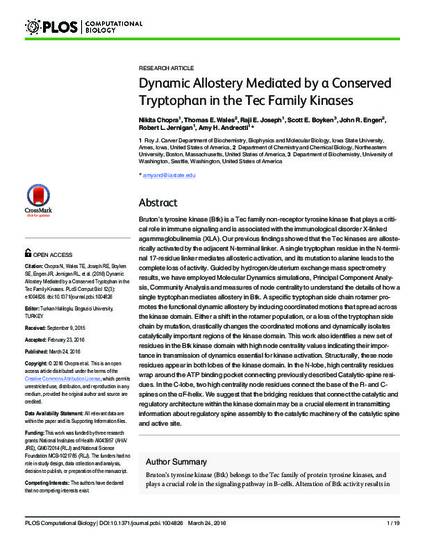
Bruton’s tyrosine kinase (Btk) is a Tec family non-receptor tyrosine kinase that plays a critical role in immune signaling and is associated with the immunological disorder X-linked agammaglobulinemia (XLA). Our previous findings showed that the Tec kinases are allosterically activated by the adjacent N-terminal linker. A single tryptophan residue in the N-terminal 17-residue linker mediates allosteric activation, and its mutation to alanine leads to the complete loss of activity. Guided by hydrogen/deuterium exchange mass spectrometry results, we have employed Molecular Dynamics simulations, Principal Component Analysis, Community Analysis and measures of node centrality to understand the details of how a single tryptophan mediates allostery in Btk. A specific tryptophan side chain rotamer promotes the functional dynamic allostery by inducing coordinated motions that spread across the kinase domain. Either a shift in the rotamer population, or a loss of the tryptophan side chain by mutation, drastically changes the coordinated motions and dynamically isolates catalytically important regions of the kinase domain. This work also identifies a new set of residues in the Btk kinase domain with high node centrality values indicating their importance in transmission of dynamics essential for kinase activation. Structurally, these node residues appear in both lobes of the kinase domain. In the N-lobe, high centrality residues wrap around the ATP binding pocket connecting previously described Catalytic-spine residues. In the C-lobe, two high centrality node residues connect the base of the R- and C-spines on the αF-helix. We suggest that the bridging residues that connect the catalytic and regulatory architecture within the kinase domain may be a crucial element in transmitting information about regulatory spine assembly to the catalytic machinery of the catalytic spine and active site.
Available at: http://works.bepress.com/amy_andreotti/18/

This article is published as Chopra, Nikita, Thomas E. Wales, Raji E. Joseph, Scott E. Boyken, John R. Engen, Robert L. Jernigan, and Amy H. Andreotti. "Dynamic allostery mediated by a conserved tryptophan in the Tec family kinases." PLoS computational biology 12, no. 3 (2016): e1004826. doi:10.1371/journal.pcbi.1004826. Posted with permission.